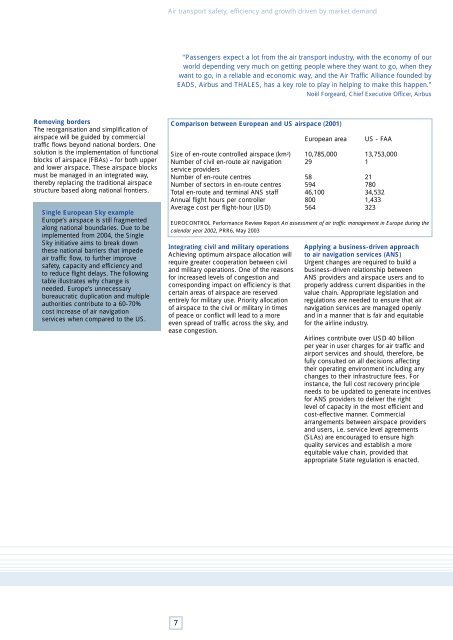ATAG Corporate brochure
ATAG Corporate brochure
ATAG Corporate brochure
Create successful ePaper yourself
Turn your PDF publications into a flip-book with our unique Google optimized e-Paper software.
Removing borders<br />
The reorganisation and simplification of<br />
airspace will be guided by commercial<br />
traffic flows beyond national borders. One<br />
solution is the implementation of functional<br />
blocks of airspace (FBAs) – for both upper<br />
and lower airspace. These airspace blocks<br />
must be managed in an integrated way,<br />
thereby replacing the traditional airspace<br />
structure based along national frontiers.<br />
Single European Sky example<br />
Europe’s airspace is still fragmented<br />
along national boundaries. Due to be<br />
implemented from 2004, the Single<br />
Sky initiative aims to break down<br />
these national barriers that impede<br />
air traffic flow, to further improve<br />
safety, capacity and efficiency and<br />
to reduce flight delays. The following<br />
table illustrates why change is<br />
needed. Europe’s unnecessary<br />
bureaucratic duplication and multiple<br />
authorities contribute to a 60-70%<br />
cost increase of air navigation<br />
services when compared to the US.<br />
Air transport safety, efficiency and growth driven by market demand<br />
"Passengers expect a lot from the air transport industry, with the economy of our<br />
world depending very much on getting people where they want to go, when they<br />
want to go, in a reliable and economic way, and the Air Traffic Alliance founded by<br />
EADS, Airbus and THALES, has a key role to play in helping to make this happen."<br />
Noël Forgeard, Chief Executive Officer, Airbus<br />
Comparison between European and US airspace (2001)<br />
7<br />
European area US - FAA<br />
Size of en-route controlled airspace (km 2) 10,785,000 13,753,000<br />
Number of civil en-route air navigation 29 1<br />
service providers<br />
Number of en-route centres 58 21<br />
Number of sectors in en-route centres 594 780<br />
Total en-route and terminal ANS staff 46,100 34,532<br />
Annual flight hours per controller 800 1,433<br />
Average cost per flight-hour (USD) 564 323<br />
EUROCONTROL Performance Review Report An assessment of air traffic management in Europe during the<br />
calendar year 2002, PRR6, May 2003<br />
Integrating civil and military operations<br />
Achieving optimum airspace allocation will<br />
require greater cooperation between civil<br />
and military operations. One of the reasons<br />
for increased levels of congestion and<br />
corresponding impact on efficiency is that<br />
certain areas of airspace are reserved<br />
entirely for military use. Priority allocation<br />
of airspace to the civil or military in times<br />
of peace or conflict will lead to a more<br />
even spread of traffic across the sky, and<br />
ease congestion.<br />
Applying a business-driven approach<br />
to air navigation services (ANS)<br />
Urgent changes are required to build a<br />
business-driven relationship between<br />
ANS providers and airspace users and to<br />
properly address current disparities in the<br />
value chain. Appropriate legislation and<br />
regulations are needed to ensure that air<br />
navigation services are managed openly<br />
and in a manner that is fair and equitable<br />
for the airline industry.<br />
Airlines contribute over USD 40 billion<br />
per year in user charges for air traffic and<br />
airport services and should, therefore, be<br />
fully consulted on all decisions affecting<br />
their operating environment including any<br />
changes to their infrastructure fees. For<br />
instance, the full cost recovery principle<br />
needs to be updated to generate incentives<br />
for ANS providers to deliver the right<br />
level of capacity in the most efficient and<br />
cost-effective manner. Commercial<br />
arrangements between airspace providers<br />
and users, i.e. service level agreements<br />
(SLAs) are encouraged to ensure high<br />
quality services and establish a more<br />
equitable value chain, provided that<br />
appropriate State regulation is enacted.

















